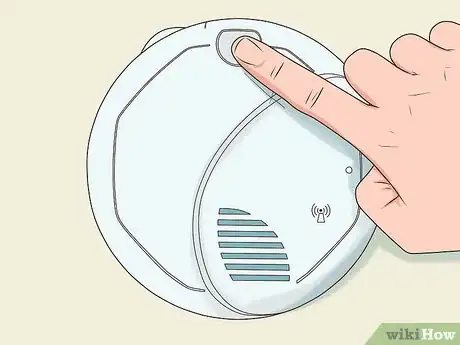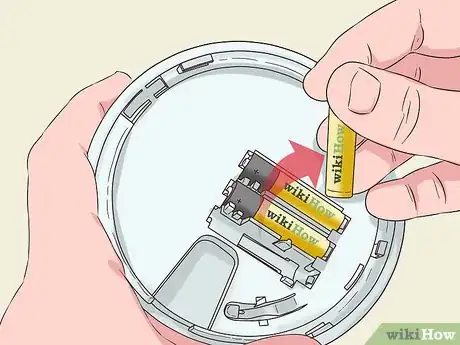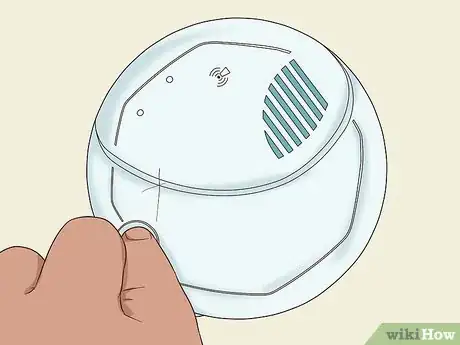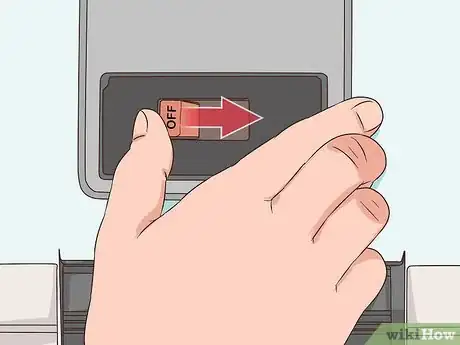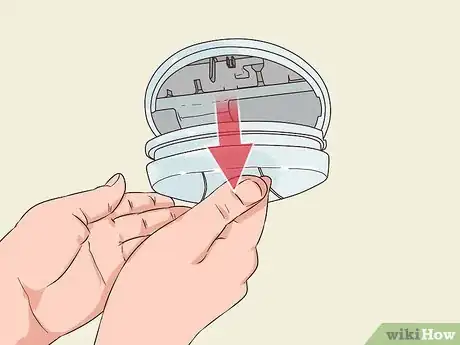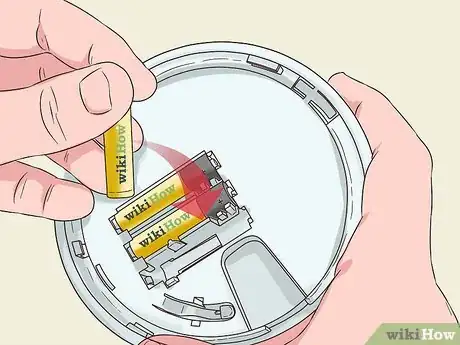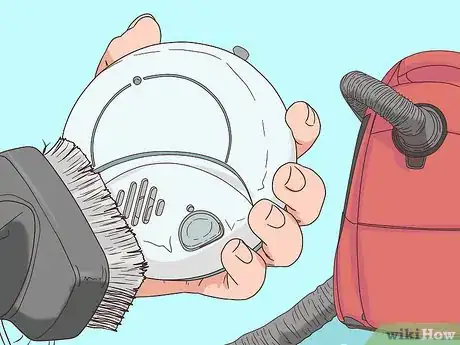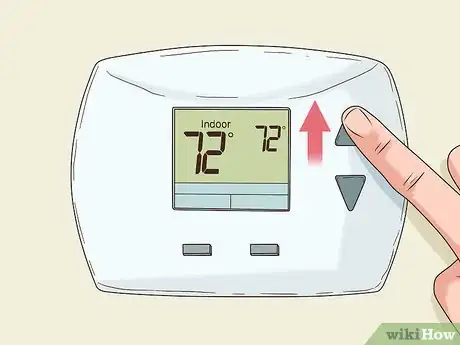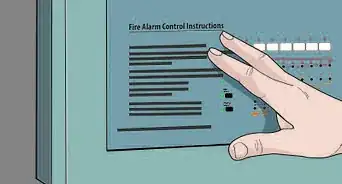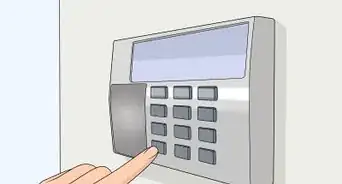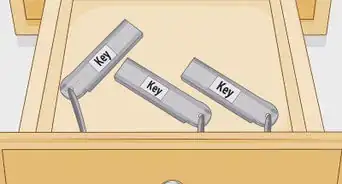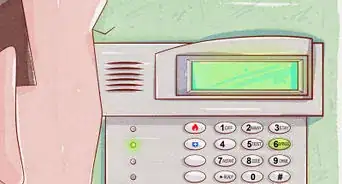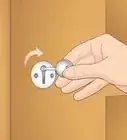This article was co-authored by wikiHow staff writer, Kyle Hall. Kyle Hall works on the content team at wikiHow. He helps manage our team of editors and creates content for a variety of wikiHow projects. Kyle continually looks for new ways to improve the content at wikiHow and make it more helpful and enjoyable for readers. He graduated from Eckerd College in 2015, where he majored in Political Science.
This article has been viewed 94,331 times.
Learn more...
If your smoke alarm goes off, assume there’s a fire and take immediate action. However, if you realize it’s a false alarm, there are ways you can manually turn off your alarm so the noise doesn't drive you crazy. If your alarm is just making a chirping noise, there are still some things you can do to get it to turn off.
Things You Should Know
- Pressing and holding the reset button should get the alarm to stop making noise.
- If the smoke alarm beeps periodically every 45 seconds or so, replacing the batteries should do the trick.
- If your hardwired smoke alarm is still making noise after you’ve shut off the power, check for backup batteries.
Steps
Stopping Battery-Powered Alarms
-
1Press and hold the reset button on your smoke alarm. The reset button is usually in the center of the alarm or somewhere on the front. If you don’t see a button, feel around the sides of your alarm with your fingers to see if the button is there. When you find it, press and hold it down until the alarm stops.[1]
- If your smoke alarm is up high and you can’t reach it, carefully stand on a sturdy chair to push the button. If there’s anyone else with you, have them spot you while you’re on the chair.
-
2Take your smoke alarm down if the alarm noise doesn’t stop. Grab hold of the smoke alarm and gently pull it away from the wall. You may need to turn the alarm counterclockwise for it to come off. Once it’s slightly off the wall, reach your hand behind to feel for any wiring. If there are wires, unclip the connector that’s connecting the wiring in the alarm to the wiring on the wall.[2]Advertisement
-
3Remove the batteries from your smoke alarm. There may be a battery cover over the batteries. If so, look for a plastic latch on one of the edges of the cover. Press it in with your finger and lift the battery cover off the smoke alarm. Once the cover is off, pull the batteries out from the smoke alarm. The alarm should stop going off.[3]
- If you can’t get the cover off with your finger, try using a flathead screwdriver to pry it off.
-
4Wrap your alarm in a blanket to muffle the noise if the batteries won’t come out. If your smoke alarm has a lithium battery, you may not be able to remove it. Put your blanket-wrapped alarm under a couch cushion or in your freezer until it stops going off.[4]
Turning Off Hardwired Alarms
-
1Press and hold the reset button on each smoke alarm in your house. Hardwired smoke alarms are all connected, so you’ll need to try resetting them all to figure out which one is causing the alarm to go off. Look for a reset button in the center of the alarms, or somewhere else on the front or sides. Press and hold the button on each smoke alarm, one at a time, until the alarm goes off.[5]
-
2Turn your circuit breaker off and back on if the alarm noise doesn’t stop. Locate the service panel in your house. Service panels usually look like gray boxes on the wall, and they’re sometimes in the garage or basement. Once you find the panel, open the door to the panel and look for the main breaker switch. If it’s not labeled, look for a switch that’s bigger than the rest and that’s at the top of the panel. When you find it, flip the switch to the off position and then flip it back on. The alarm should stop going off.[6]
-
3Take down your smoke alarms if the alarm doesn’t stop. One at a time, pull each alarm away from the wall or ceiling. Reach behind each alarm and unclasp the connector that’s connecting the wiring in the alarm to the wiring in the walls.[7]
- If you can't reach the alarms, stand on a sturdy chair to take them down. Ask someone to spot you while you are up on the chair.
-
4Remove any backup batteries in your smoke alarms. Some hardwired smoke alarms have backup batteries in them. Look for a battery cover with a plastic latch on one side. Use your finger or a screwdriver to push the latch in and lift the battery cover up from the alarm. Pull out the batteries inside.[8]
Getting Your Alarm to Stop Chirping
-
1Replace the batteries in your smoke alarm. If your smoke alarm is making a chirping noise, it may mean the batteries are almost dead. To switch out the batteries, remove your smoke alarm from the wall or ceiling. If your smoke alarm has a battery cover, remove it by pressing the plastic latch on the side of the cover in and lifting up the cover. Then, take out the old batteries and insert brand new ones.[9]
- You may need to press and hold the reset button on your smoke alarm after you change the batteries.
-
2Clean out your smoke alarm with a vacuum and hose attachment. Sometimes accumulated dust and dead bugs inside smoke alarms can cause them to chirp. Remove your smoke alarm from the wall or ceiling. Vacuum over the vents and openings on your smoke alarm to remove any build up inside. When you're finished, reset your smoke alarm by pressing and holding the reset button.[10]
-
3Change the temperature settings in your house. If your smoke alarm only chirps at certain times, like in the middle of the night or during the day when you're at work, it may be responding to dramatic temperature fluctuations in your house. Adjust your thermostat so the temperature is more consistent throughout the day and see if that makes the chirping stop.[11]
Community Q&A
-
Questionwhy do hotels/motels insist on not allowing responsible cigarette smokers the right to enjoy a ciggie in the room they have paid for?
 Community AnswerBecause the smell is very hard to get rid of, and the nicotine can stain white light fixtures and windowsills. Plus, the person who comes in after you may have an allergy to the smoke.
Community AnswerBecause the smell is very hard to get rid of, and the nicotine can stain white light fixtures and windowsills. Plus, the person who comes in after you may have an allergy to the smoke. -
QuestionWhat is the lifespan for smoke alarms?
 Upnorth HereTop AnswererThe manufacturers of most residential consumer smoke alarms recommend replacement no later than 10 years after installation. Some CO alarms (in combination with smoke alarms) may have sensors that fail sooner than that. In commercial installations, the contracted maintenance technicians must routinely test the alarms and sensors and replace any that fail, which may be less than 10 years or more.
Upnorth HereTop AnswererThe manufacturers of most residential consumer smoke alarms recommend replacement no later than 10 years after installation. Some CO alarms (in combination with smoke alarms) may have sensors that fail sooner than that. In commercial installations, the contracted maintenance technicians must routinely test the alarms and sensors and replace any that fail, which may be less than 10 years or more.
References
- ↑ https://www.consumerreports.org/smoke-alarms/how-to-reset-a-smoke-alarm-that-wont-stop/
- ↑ https://www.consumerreports.org/smoke-alarms/how-to-reset-a-smoke-alarm-that-wont-stop/
- ↑ https://www.consumerreports.org/smoke-alarms/how-to-reset-a-smoke-alarm-that-wont-stop/
- ↑ https://www.consumerreports.org/smoke-alarms/how-to-reset-a-smoke-alarm-that-wont-stop/
- ↑ https://www.consumerreports.org/smoke-alarms/how-to-reset-a-smoke-alarm-that-wont-stop/
- ↑ http://www.bhg.com/home-improvement/electrical/how-to-turn-off-power/
- ↑ https://www.consumerreports.org/smoke-alarms/how-to-reset-a-smoke-alarm-that-wont-stop/
- ↑ https://www.consumerreports.org/smoke-alarms/how-to-reset-a-smoke-alarm-that-wont-stop/
- ↑ https://www.bobvila.com/articles/smoke-detector-beeping/
About This Article
To stop a smoke alarm, press and hold the reset button in the middle of the alarm. If you don’t know which box triggered the alarm, hold the reset button on all of them. If that doesn’t work, you’ll need to disconnect its power source. For a hardwired alarm, turn off the main circuit breaker in your house. Or, if your alarm is battery-powered, gently pull it away from the wall and remove its batteries to silence it. You may need to twist it counterclockwise for it to come off. For more tips, including how to stop your smoke alarm intermittently chirping, read on!
